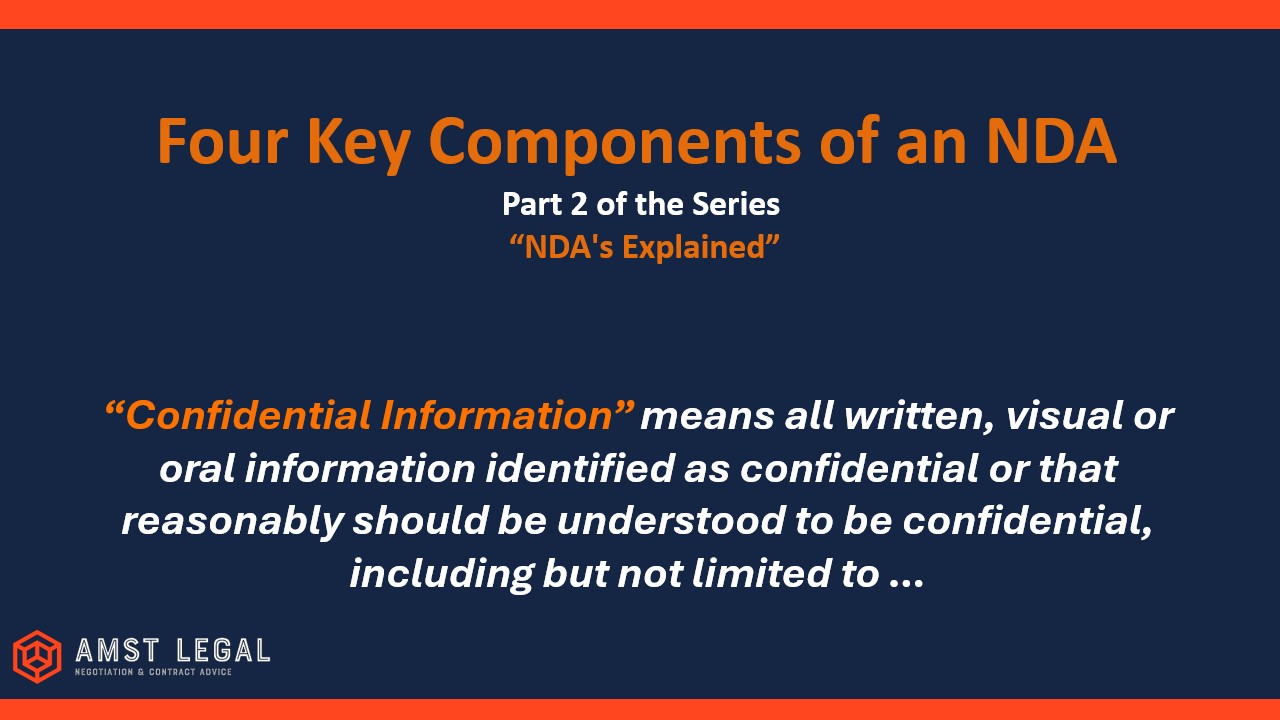
Contract Management: Two Simple Tips to Optimize Your Contract Templates
Introduction: Understanding Contract Optimization
In today’s business environment, efficiency and clarity in contract management are more crucial than ever. One question we frequently encounter is, “What exactly is Contract Optimization Advice?” This concept might seem intricate at first glance, but it’s fundamentally about streamlining your contract processes to save time, reduce errors, and ensure legal compliance. Let me illustrate this with a straightforward example from our recent advisory work.
The Challenge: Streamlining Contract Processes for Enhanced Efficiency
A client approached us with a common yet complex challenge. They had two separate (fairly long) customer contracts in use, signed approximately 100 times each year. These contracts were:
- A standard customer contract for clients not receiving subsidies or government funding.
- A standard customer contract for clients that do receive such financial support.
They asked us to improve the wording of the contract, ensuring that companies signing the contracts understood the contracts sufficiently, avoiding legal jargon where possible. Additionally, they asked to advise them how to amend the contract in such a way that processes would be more efficient. Most importantly, we would of course focus on lowering the risks for the company, where reasonably possible.
Both contracts included a pricing annex, which was subject to regular updates.
Our Approach: Simplification and Innovation
After a brief introductory call with the client and a review of the contracts, we proposed a straightforward yet innovative solution. Our advice focused on two initial key changes which we already proposed without going into the details of the full contracts.
- Consolidation into One Contract: We recommended merging the two contracts into a single document with a distinct annex for subsidy or funding conditions. This approach not only simplifies the contract management process but also ensures that all customers are subject to the same core terms and conditions, promoting fairness and transparency.
- Digital Pricing Updates: To address the challenge of the frequently updated pricing annex, we suggested adding a link to the pricing information on the company’s website. This allows for real-time updates to be made accessible immediately after notifying customers, thereby significantly reducing administrative burdens and enhancing operational efficiency.
The Impact: A Smoother Path to Business Success
Our client implemented these changes and observed a noticeable improvement in their contract negotiation times and overall legal process efficiency. More importantly, this optimization made their business operations smoother and their customers happier by providing clearer, more accessible contract terms.
Conclusion: Let Us Simplify Your Contractual Challenges
Contract optimization is more than a service; it’s a pathway to enhancing your business’s operational efficiency and customer satisfaction. By embracing simplicity and leveraging technology, we can help you navigate the complexities of contract management with ease.
Are you ready to streamline your contract processes and make your business life easier? Contact us for tailored contract optimization advice. Book an appointment with us to discuss possibilities for your company.
Tags: #AMSTLegal #ImproveYourContracts #ImproveYourTemplates #Negotiation #ContractLaw #LegalEfficiency #Legal #CommercialContracts

How to improve your Contract Processes with Better Cooperation
Legal should focus on Better Cross-Departmental Cooperation
As we have highlighted in previous posts, it takes leadership and a team to improve your contract templates. Once Legal has taken the lead and the centralized responsibility to improve the contract templates, the next step is to involve and work together on this goal with other departments. The creation and use alone of contract templates will only offer limited benefits This is not only essential to receive all required input for the contract templates, but also for a successful implementation of the contract templates.
Legal professionals often limit their interactions to their Legal colleagues or senior management when creating and implementing contract templates or negotiating contracts. This limitation, while understandable, can lead to contract templates and agreed contracts that are legally sound but are missing critical business insights.
Additionally, as mentioned above, the complexity, inaccuracy and lack of processes will lead to the use of unauthorized or outdated templates and excessive Legal Review due to lack of internal processes and support from other departments.
Insight Integration: A Collective Approach on Template Creation
Therefore, aligning contract templates with the practical realities of the business is essential. Departments such as Sales, Products, Finance and Compliance offer invaluable insights on commercial and financial risks, practical considerations and the specificities of products or services offered by the company.
This input ensures that the contract templates are not only legally robust, but also fit in the commercial roadmap of the company and cover all other company risks (e.g. technical, compliance, operational and financial).
Another important reason to involve these departments in the drafting process of the templates is to create a sense of ownership and support from these stakeholders. When departments contribute in the development of the standardized contract templates of a company, they are more likely to endorse and actually use the templates. This collaborative approach not only enhances the quality and relevance of the contract templates but also ensures their acceptance and utilization across the organization, ultimately leading to smoother operations and reduced risks.
Enhancing Cross-Departmental Collaboration – Improve Communication & Cooperation
Legal´s role in improving the communication and cooperation with the rest of the company cannot be understated. Regular, strategic meetings between Legal and other departments are essential to set the stage for a more integrated and efficient approach to contract management of the company.
These discussions should focus on:
- a) Strategic Alignment: First, Legal needs to clearly communicate its short and long term intended contract optimization strategy to all departments. Secondly, these departments should share their strategy and specific requirements and contributions to the contract process and templates. This will give Legal the opportunity to create and roll-out the best strategy to improve the Company´s contract processes and templates.
- b) Issue Identification and Resolution: Facilitating an open dialogue where Legal and all other departments can highlight challenges encountered with current templates and collaboratively develop solutions to streamline cooperation and reduce operational burdens.
- c) Training and Involvement: Initiating internal workshops to educate teams on optimal contract template usage, Legal engagement policies, while encouraging feedback and suggestions for improvements to ensure templates remain relevant and effective.
- d) Proactive Communication: Discussing the optimization of the empowerment of the commercial teams, meaning that all relevant contract-related documents and information are proactively shared with customers and partners by the Sales, Partnerships and Procurement teams.
This will greatly minimize the workload of Legal and maximize their output due to a decreased need of Legal clarifications and Legal involvement in negotiations. The importance of regular, inclusive meetings and training sessions cannot be overstated. When planning, it is essential to engage every layer of the organization, from grassroots employees to top management, in strategic discussions and trainings.
These sessions serve as a cornerstone for aligning strategies, creating an environment where all team members are equipped with the knowledge and skills to navigate the complexities of the contract optimization process and their roles effectively.
By maintaining a consistent schedule of these critical discussions and training, organizations can avoid the pitfalls of reactionary measures during peak periods of activity. Instead, a well-informed and strategically aligned team will be ready to handle the demands of the business efficiently, ensuring continuity and resilience in the face of challenges.

Contract Negotiations: How to Avoid Negative Reactions in Redlines and Mark-ups
𝗤𝘂𝗶𝗰𝗸 𝗖𝗼𝗻𝘁𝗿𝗮𝗰𝘁 𝗡𝗲𝗴𝗼𝘁𝗶𝗮𝘁𝗶𝗼𝗻 𝗧𝗶𝗽 𝗼𝗳 𝘁𝗵𝗲 𝗗𝗮𝘆: When reacting to a comment or suggested wording by a counterparty that is commenting on your contract, 𝘢𝘷𝘰𝘪𝘥 using negative language like:
“Adding this wording in the Article is incorrect because it has already been covered in Art. 12.”
Instead, try saying:
“Thank you for your comment. I agree with your addition. Please note that we have already covered this in Art. 12.”
Additionally, for important subjects, you can add:
“If you do not agree with this wording, please let me know”; and/or
“Please let me know if you would like to discuss this topic during our next meeting”.
As we know, during contract negotiations, it’s important to maintain a cooperative relationship with the other party. Remember, the counterparty is also just doing their job and you are working together to reach a mutually advantageous outcome.
By using positive language in your reactions to comments, you can help keep negotiations running smoothly and maintain a good relationship with the counterparty.
For a bit more background on The Importance of a Relationship in Negotiations, please see the following article on the Harvard website.
See our original post on this subject on LinkedIn
#ContractNegotiations #HowtoNegotiateBetter #ContractLaw #AMSTLegal #contracts #negotiation #negotiationskills #relationshipbuilding

Legal in the Lead when improving Contract Templates
To improve your contracts, it is no surprise that we recommend Legal to take the lead in creating and implementing contract templates, particularly for critical documents such as loan agreements, general terms & conditions, DPAs (data processing agreements), etc.
Depending on the maturity of an organisation, leadership and commercial teams often overlook the necessity of Legal approval, which leads to inefficiencies and the risks mentioned in the previous articles on this subject. Even though it might be perceived as slowing down processes, it is advised to let Legal take the lead when creating, amending and rolling out your company´s contract templates.
To illustrate this, see two scenario´s that we encounter in practice:
a) Small Businesses and Start-ups: founders or commercial teams in smaller enterprises rely on freely available online templates or self-made documents. While this is an understandable practical approach in the early stages of a company, it is vital to re-evaluate these initial templates in consultation with Legal.
b) Corporates: even in larger organisations with state of the art templates, it is not unusual that commercial and operational teams use their own, unapproved versions tailored for specific products or services. Case study: For example, when advising a company with 120 employees, we encountered 40 different contract templates of the same Sales Contract – one for each product! As the company – understandably – had serious contract efficiency issues, we worked on successfully consolidating this into three contract templates.
Contracting is a highly cross-functional activity (or at least it should be).2 Legal leadership is nothing without involvement from the other departments in a company. How to do this, we will explain in the next tip in the series how to improve your contract templates.
Doesn´t Legal slow down processes?
There is still a common perception that Legal will slow down processes, which is not correct if Legal embraces the possibilities of (i) standardizing and simplifying the contract templates, (ii) working towards the 80/20 Template Ratio and (ii) contract automation. The research on this subject also confirms that – as we have also experienced in practice in many different companies – that it will actually speed up your processes. Lastly, this is also substantiated by the interest in Legal Tech & CLM (Contract Lifecycle Management) tools offered that automate and streamline contract processes during key stages in the contract lifecycle.
To improve contract templates, more work will indeed need to be done at the start of the process to ensure that the standards not only contain legal, but also business requirements. Once the contract templates have been created and includes the input from all teams (see next tip 4), the standardized templates can be used without input from Legal – which will greatly improve the efficiency, scalability and negotiation time for your contracts.
Automation and Empowerment Commercial Team
Once these contract templates are final, these templates can be made available internally and/or externally depending on the type of contract, for example:
online (Terms and Conditions, DPA, SLA (Service Level Agreement)
contract management software (e.g. Customer Agreement, NDA (Non-Disclosure Agreement), Order Forms; and/or
by the commercial teams (Enterprise Customer Contract, Partner Agreements, Master Services Agreement).
It is therefore crucial to have a central repository and/or automate the access to the contract templates to empower the commercial teams to use the contract templates within the agreed framework. Commercial teams need to be enabled to complete and send out contracts (e.g. Enterprise Customer Contracts, NDAs and Partner Agreements) that are made using the template contracts. More on this in point 5 below.
Broadened Scope
Key to this approach is that Legal is not only involved in leading the effort in creating typical contract templates like NDAs, sales or partnerships agreements, but also documents such as Service Level Agreements, Offer Documents and Order Forms. Once these agreements have been agreed by Legal and the rest of the company, they can be used at scale within the agreed framework.
The Role of Legal
Legal should oversee the drafting, implementation and management of these contract templates to ensure accurate and compliant use of the templates across the organization. Once Legal is in the lead of the contract templates and the business is working according to the 80/20 Contract Template – unsurprisingly – it typically first leads to more work for Legal. This is caused by the fact that Legal now has control over all contracts that are sent out by the company. This is why automation and empowerment of other teams is so crucial.
This brings us to the next points that Legal should focus on: (i) involving other departments in the company and (ii) improving the communication and cooperation with other departments, which we will discuss in our next post

NDAs Explained – What You Need to Know (part 1)
NDAs ensure that confidential information is used solely for the specified purpose set out between the parties in a business relationship. In the world of business, where ideas, innovations, financial information and secrets are the keys to success, Non-Disclosure Agreements (NDAs) often play an important role in protecting a company’s confidential information. This article will provide a comprehensive overview of NDAs in the context of Business to Business (B2B) dealings.
What is an NDA?
An NDA, also referred to as a Confidentiality Agreement, is a legally binding contract between two or more parties to protect confidential information which may be shared during the course of their business relationship. More specifically, confidential information is non-public information of a company that could harm the company when it would be shared in public. Usually a list of the Confidential information is included in the NDA, containing for example: trade secrets, know-how, products and technology-related information, discounts, customer lists, sales and financial information, business plans, etc.
Why and when do we need an NDA?
In the B2B context, NDAs can be an essential tool for protecting proprietary knowledge, trade secrets and other confidential data that is important for a company to maintain its competitive advantages. That sensitive information, therefore, should be defined clearly and carefully in NDAs. However, be careful not to define it too narrow to ensure that you have not missed an important category. By using a properly drafted NDA, your company can secure valuable information from competitors or other third parties who may benefit from the disclosure of such information.
Primary objective
The primary objective of an NDA is to ensure the disclosed sensitive information is securely used and handled, preventing its use or disclosure without proper permission and authorization by the disclosing party. An NDA is often signed at the beginning of a business relationship or before entering into a business relationship.
Example
Common example: a technology company is planning to sell and offer specialized software solutions to an enterprise customer. The companies start by discussing how to integrate the software into the customer’s systems to ascertain the price for the integration and the use of the software. For this, the technology company might share insights about their pricing, SLA, policies and software, and the customer, in turn, might explain their challenges and share business plans. While doing so, the companies therefore plan to share documents including non-public, hence confidential information. This is why it is advised that these companies sign an NDA before sharing this confidential information to each other. Such an NDA can be terminated when the parties sign a final customer contract, which should also include confidentiality terms.
How does an NDA protect your confidential information?
Like any other legal contracts, an NDA carries important legal consequences for breach of contract. Depending on the severity of a breach, its consequence can range from lawsuits, financial penalties to – in extreme cases – criminal charges. Breaching an NDA can also harm a party’s reputation, which may lead to other long-lasting consequences to its business, especially in business relationships and industries where trust and confidentiality are crucial.
Claims and lawsuits relating to a breach of an NDA are not common, but it absolutely happens that a company needs to pay out a penalty for breach of confidentiality. We have even advised on this matter a few times in the past.
What type of NDA do you need?
There are various types of NDA that can be used based on the specific circumstances and the needs of the parties involved. Below are the three common types of NDA:
- Unilateral NDA (One-sided NDA): In a unilateral NDA, one party, typically the seller, imposes on the other party the obligation to secure the information and not to disclose or use the information for any purpose other than what is specified in the agreement. In a B2B context, unilateral NDAs are often used between buyers and sellers. For instance, a Biotech company (seller), may employ a unilateral NDA to prevent the buyer from disclosing sensitive information they have gained during the purchase of products or services, such as intellectual property and computer technology. Also common in Public Tenders and for RFI (Request for information) in RFP (Request for Price) situations.
- Mutual NDA (Two-sided or Mutual NDA): A mutual NDA involves two parties, and both parties will be sharing sensitive information with each other and agree that both sides will be bound by confidentiality obligations. Mutual NDAs are frequently used when the parties need to exchange considerable amounts of confidential information during their negotiations or business relationship. Such situations can be Joint Ventures, Vendor Contracts or Mergers and Acquisitions.
- Multilateral NDA (Three or More Parties NDA): A multilateral NDA includes three or more parties, where at least one party shares sensitive information with other parties and enforces confidentiality obligations. This type of NDA streamlines the paperwork and administration for the parties in a sense that the parties do not need to enter several unilateral or bilateral NDAs with one another. In a business relationship involving three parties, where all anticipate disclosing confidential information, a single multilateral NDA can replace the need for three different bilateral NDAs between each pair of parties. Such situations can be Partnerships, Government Contracts (like defense and aerospace contracts) and Consortium Agreements.

How to roll-out a new Contract Template #6 – Meetings
Introduction
Last but not least! Here is part 6 and last part of my tips on how to roll-out a new Contract Template as an Expert.
Once you have sent out the new templates, these next steps are most important to ensure that the team will really use the templates. In this part of the series ‘How to roll-out a new Contract Template #6 – Meetings’ we focus on meetings and training sessions you should set up with your team.
How to roll-out a new Contract Template #6 – Meetings
𝗧𝗮𝗸𝗲 𝘁𝗵𝗲𝘀𝗲 𝗳𝗼𝗹𝗹𝗼𝘄-𝘂𝗽 𝗮𝗰𝘁𝗶𝗼𝗻𝘀 𝗮𝗳𝘁𝗲𝗿 𝗿𝗼𝗹𝗹𝗶𝗻𝗴 𝗼𝘂𝘁 𝘆𝗼𝘂𝗿 𝗻𝗲𝘄 𝗖𝗼𝗻𝘁𝗿𝗮𝗰𝘁 𝗧𝗲𝗺𝗽𝗹𝗮𝘁𝗲
By following these last steps when sending out contract templates, you can optimize the contract management at your company. Consequently, this will create a more efficient and effective working environment with less discussions about the templates. If you train the teams well and empower them sufficiently you will also see that the negotiation process will run much smoother.
𝗦𝗲𝗽𝗮𝗿𝗮𝘁𝗲 𝗺𝗲𝗲𝘁𝗶𝗻𝗴𝘀 𝘄𝗶𝘁𝗵 𝗺𝗮𝗻𝗮𝗴𝗲𝗺𝗲𝗻𝘁
Address and discuss the goals of the new Contract Template and raise specific concerns and considerations, engaging key stakeholders individually.
Full team meetings:
Provide comprehensive explanations of new templates/policies, emphasizing their purpose, benefits, and alignment with company goals.
𝗧𝗿𝗮𝗶𝗻𝗶𝗻𝗴 𝘀𝗲𝘀𝘀𝗶𝗼𝗻𝘀
Train and empower colleagues with the necessary skills and knowledge to implement the contract templates effectively.
Centralized document access
Establish a user-friendly location for all internal standards, guiding team members to easily find necessary documentation.
𝗥𝗲𝗴𝘂𝗹𝗮𝗿 𝗺𝗼𝗻𝗶𝘁𝗼𝗿𝗶𝗻𝗴
Check awareness, adherence, and effectiveness of procedures, identifying areas for improvement and ensuring compliance.
Support and guidance:
Offer ongoing support to help guide your colleagues by proposing one on one meetings and training sessions.
𝗙𝗲𝗲𝗱𝗯𝗮𝗰𝗸 𝗳𝗼𝗿 𝗶𝗺𝗽𝗿𝗼𝘃𝗲𝗺𝗲𝗻𝘁:
Create opportunities for feedback to drive future enhancements. Actively ask your team members for feedback in the training sessions and meetings mentioned above.
Conclusion
As legal professionals, we play a vital role to improve compliance, efficiency and risk mitigation. By implementing these tips, we create a more productive and legally sound workplace with the ultimate goal: more fun at work and driving success for the company. Most importantly, when doing so, we work together with the other teams and we do not only dictate what they should do.
Easier said, this way:
- You will waste less time in trying to (i) find the right template or (ii) figure out how to use it or who to involve when you have issues
- Your colleagues at the Legal department will have more time to dive deeper into your legal issues and have more time to negotiate and advise you from a legal and strategic point of view
- The other teams of the company will feel more involved- it will be very hard for your colleagues to say that they do not know where to find the Contract Templates (sound familiar?)
- Your Contracts will be signed quicker!
To see the other parts in this series, go to: bit.ly/amstlegal-blogs

Communicating Your New Contract Template to All Team Members
As part 5 of my tips on how to roll-out a new Contract Template as an Expert, the following:
! 𝗚𝗲𝘁 𝗘𝘃𝗲𝗿𝘆𝗼𝗻𝗲 𝗼𝗻 𝗕𝗼𝗮𝗿𝗱: 𝗖𝗼𝗺𝗺𝘂𝗻𝗶𝗰𝗮𝘁𝗶𝗻𝗴 𝗬𝗼𝘂𝗿 𝗡𝗲𝘄 𝗖𝗼𝗻𝘁𝗿𝗮𝗰𝘁 𝗧𝗲𝗺𝗽𝗹𝗮𝘁𝗲 𝘁𝗼 𝗔𝗹𝗹 𝗧𝗲𝗮𝗺 𝗠𝗲𝗺𝗯𝗲𝗿𝘀
Once your template is final, approved internally and previous tips are followed, send out your New Template / Procedure using a communication method that is tailored to your company.
Do not use a single communication method (e.g. only providing the template via e-mail). This will significantly decrease the use of the New Template.
When rolling out a new contract template in your company, it is important to use multiple channels of communication to ensure that team members are informed and understand how to use it. It is recommended to combine the following communication methods:
* Your company’s intranet or internal portal
* Collaboration software like Slack or Microsoft Teams
* Email
* Kick-off meetings/trainings
This combination will help to increase the visibility of the new Contract Template and provide team members with the opportunity to ask questions and address any concerns.
Remember that clear communication is key to the successful implementation of a new contract template.
𝗣𝗿𝗼-𝘁𝗶𝗽: In case of new Contract Templates or Legal Procedures, it is advised to cascade the communication as follows:
* First to each Head of the Commercial Team / Regional Leader who can share/discuss it with their team and reiterate the importance of the new Contract Template/Procedure
* Legal Team sends it to the Commercial Team
* For particularly important messages set up separate meetings between Legal Team members and Commercial Team members
To avoid the common issue that team members are not able to find the e-mail or other communication that you used sending out the new template, follow one of my previous tips: create one central location for all your templates.
𝗪𝗵𝗮𝘁 𝘄𝗲 𝗵𝗮𝘃𝗲 𝗹𝗲𝗮𝗿𝗻𝗲𝗱 𝗳𝗿𝗼𝗺 𝗽𝗿𝗲𝘃𝗶𝗼𝘂𝘀 𝗽𝗼𝘀𝘁𝘀 𝗶𝗻 𝘁𝗵𝗶𝘀 𝘀𝗲𝗿𝗶𝗲𝘀:
– The top-down approach does not work
– Team members need to know the critical components for the use of the new Contract Templates: the Why, How, When and Benefits
– Create and follow a strategic communication and follow-up plan (the Communication Plan):
– Step 1: Identify Relevant Users and Teams
– Step 2: Notify / Pre-inform the team about the upcoming new template
– Step 3: Make sure to cover all 10 points of the Checklist
𝘛𝘩𝘪𝘴 𝘱𝘰𝘴𝘵 𝘰𝘧 𝘱𝘢𝘳𝘵 𝘰𝘧 𝘮𝘺 𝘭𝘢𝘴𝘵 𝘵𝘪𝘱 (𝘯𝘳. 10) 𝘰𝘯 ‘𝘏𝘰𝘸 𝘵𝘰 𝘐𝘮𝘱𝘳𝘰𝘷𝘦 𝘺𝘰𝘶𝘳 𝘉𝘶𝘴𝘪𝘯𝘦𝘴𝘴 𝘊𝘰𝘯𝘵𝘳𝘢𝘤𝘵𝘴 𝘣𝘺 𝘊𝘳𝘦𝘢𝘵𝘪𝘯𝘨 𝘎𝘳𝘦𝘢𝘵 𝘊𝘰𝘯𝘵𝘳𝘢𝘤𝘵 𝘛𝘦𝘮𝘱𝘭𝘢𝘵𝘦𝘴’.

How to Roll-Out your New Contract Template: 10 point Checklist
This is part 4 of my tips how to Roll-Out your New Contract Template as an Expert.
𝗪𝗵𝗮𝘁 𝘄𝗲 𝗵𝗮𝘃𝗲 𝗹𝗲𝗮𝗿𝗻𝗲𝗱 𝗳𝗿𝗼𝗺 𝗽𝗿𝗲𝘃𝗶𝗼𝘂𝘀 𝗽𝗼𝘀𝘁𝘀 𝗶𝗻 𝘁𝗵𝗶𝘀 𝘀𝗲𝗿𝗶𝗲𝘀:
* The top-down approach does not work
* Focus on the Why, How, When and Benefits
* Make a Communication Plan
* Identify Relevant Users and Teams
* Notify / Pre-inform the team about the upcoming new template
𝗡𝗲𝘅𝘁 𝘁𝗶𝗽: 𝗖𝗼𝗺𝗺𝘂𝗻𝗶𝗰𝗮𝘁𝗶𝗼𝗻 𝗖𝗵𝗲𝗰𝗸𝗹𝗶𝘀𝘁
See below a non-exhaustive checklist of the items that I would recommend to include in your message When rolling out & communicating the new Contract Template.
-𝗦𝘂𝗯𝗷𝗲𝗰𝘁 𝗟𝗶𝗻𝗲: Use a clear subject line that communicates the purpose of the email, such as “New Contract Template – [Add name relevant document] – Please Review and Adopt.”
-𝗜𝗻𝘁𝗿𝗼𝗱𝘂𝗰𝘁𝗶𝗼𝗻 (𝗪𝗵𝘆): Start with a brief introduction that outlines the importance of adopting the new contract template.
-𝗕𝗲𝗻𝗲𝗳𝗶𝘁𝘀: Provide an overview of the key features and benefits of the new contract template, highlighting how it will help streamline processes, reduce risks, and improve efficiency.
-𝗛𝗼𝘄: Add instructions on how to use the new contract template, including where to find it, how to fill it out, and any specific requirements to be aware of.
-𝗧𝗶𝗺𝗲𝗹𝗶𝗻𝗲: Clearly communicate the timeline for adoption of the new contract template.
-𝗧𝗿𝗮𝗶𝗻𝗶𝗻𝗴 𝗮𝗻𝗱 𝘀𝘂𝗽𝗽𝗼𝗿𝘁: Include information on any training or support that will be available to help team members adopt and use the new contract template effectively.
-𝗣𝗼𝗶𝗻𝘁 𝗼𝗳 𝗖𝗼𝗻𝘁𝗮𝗰𝘁: Provide a point of contact for questions or concerns regarding the new contract template (e.g. a project manager or legal representative).
-𝗔𝗰𝘁𝗶𝗼𝗻: End the message with a clear call to action, such as “Please review and adopt the new contract template by 2025, and let us know if you have any questions or concerns.”
-𝗢𝗽𝘁𝗶𝗼𝗻𝗮𝗹 – 𝗟𝗲𝗴𝗮𝗹: highlight any legal requirements, regulations or policies that must be adhered to, in order to ensure compliance and mitigate legal risks.
-𝗢𝗽𝘁𝗶𝗼𝗻𝗮𝗹 – 𝗧𝗲𝗮𝗺 𝗦𝗽𝗲𝗰𝗶𝗳𝗶𝗰𝘀: mention important specific information or operational set-up details for certain teams.

Communicate Early: Pre-inform and Notify Team Members
As part 3 of my tips on how to roll-out a new Contract Template as an Expert, the following:
𝗪𝗵𝗮𝘁 𝘄𝗲 𝗵𝗮𝘃𝗲 𝗹𝗲𝗮𝗿𝗻𝗲𝗱 𝗳𝗿𝗼𝗺 𝗽𝗿𝗲𝘃𝗶𝗼𝘂𝘀 𝗽𝗼𝘀𝘁𝘀 𝗶𝗻 𝘁𝗵𝗶𝘀 𝘀𝗲𝗿𝗶𝗲𝘀:
* The top-down approach does not work
* Team members need to know the critical components for the use of the new Contract Templates: the Why, How, When and Benefits
* Create and follow a strategic communication and follow-up plan (the Communication Plan)
* Step 1 Communication Plan: ‘Identify Relevant Users and Teams’
Now, let’s continue to the next step of the Communication Plan:
𝗦𝘁𝗲𝗽 𝟮: 𝗖𝗼𝗺𝗺𝘂𝗻𝗶𝗰𝗮𝘁𝗲 𝗘𝗮𝗿𝗹𝘆: 𝗣𝗿𝗲-𝗶𝗻𝗳𝗼𝗿𝗺 𝗮𝗻𝗱 𝗡𝗼𝘁𝗶𝗳𝘆 𝗧𝗲𝗮𝗺 𝗠𝗲𝗺𝗯𝗲𝗿𝘀
Does the team know that the new Contract Template is final and will be implemented soon?
Before actually sending and rolling out new Contract Templates, create groundwork and buy-in from senior management and each team member to make sure that they will actually use the new Contract Template now it is final.
It is important to provide opportunities to these team members to ask questions, express concerns and offer feedback. In this stage, ask these questions to yourself:
– Are the team members aware that the new Contract Template needs to be used at a certain date?
– Is the new Contract Template clear and does the team (in principle – not everyone will agree from the start) agree and appreciate the new Contract Template?
– Do they know the Why, How, When and Benefits?
𝗧𝗵𝗶𝘀 𝗰𝗮𝗻 𝗯𝗲 𝗮𝗰𝗵𝗶𝗲𝘃𝗲𝗱 𝗶𝗻 𝗮 𝗻𝘂𝗺𝗯𝗲𝗿 𝗼𝗳 𝘄𝗮𝘆𝘀:
* Have honest and open conversations with people that will use the Contract Template every day and with Senior Managers that will lead the relevant teams.
* Send out a pre-announcement e-mail / Slack of the actual intended roll-out date
* Organize meetings to explain the Why, How, When and Benefits of the new Contract Template
* Conduct Training sessions
* Involve key stakeholders in the process like Senior Management and Team Members from all Relevant Departments
* Set expectations and hold people accountable
In summary, by notifying, briefing and pre-informing team members of the upcoming Contract Template, businesses can ensure that everyone is on the same page and that team members are prepared for the upcoming changes. This can help to minimize any confusion or disruptions and increase the likelihood of a successful rollout.
𝘛𝘩𝘪𝘴 𝘪𝘴 𝘱𝘢𝘳𝘵 𝘰𝘧 𝘮𝘺 𝘭𝘢𝘴𝘵 𝘵𝘪𝘱 (10) 𝘰𝘯 𝘩𝘰𝘸 𝘵𝘰 𝘪𝘮𝘱𝘳𝘰𝘷𝘦 𝘺𝘰𝘶𝘳 𝘉𝘶𝘴𝘪𝘯𝘦𝘴𝘴 𝘊𝘰𝘯𝘵𝘳𝘢𝘤𝘵𝘴 𝘣𝘺 𝘤𝘳𝘦𝘢𝘵𝘪𝘯𝘨 𝘨𝘳𝘦𝘢𝘵 𝘊𝘰𝘯𝘵𝘳𝘢𝘤𝘵 𝘛𝘦𝘮𝘱𝘭𝘢𝘵𝘦𝘴. 𝘊𝘩𝘦𝘤𝘬 𝘵𝘩𝘦 𝘸𝘦𝘣𝘴𝘪𝘵𝘦 𝘪𝘯 𝘵𝘩𝘦 𝘤𝘰𝘮𝘮𝘦𝘯𝘵𝘴 𝘵𝘰 𝘳𝘦𝘢𝘥 𝘵𝘩𝘦 𝘰𝘵𝘩𝘦𝘳 𝘵𝘪𝘱𝘴.

